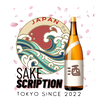The cloudy central part of a rice grain is called "shinpaku 心白" in Japanese.
It is rarely seen in the rice we commonly eat. The interior of shinpaku appears white because it has many gaps that cause light to scatter. The presence of these gaps makes it easier for the koji mold to penetrate into the inner parts of the rice, resulting in rice koji with stronger saccharification power. When it comes to rice suitable for sake brewing, characteristics such as "large grain size" and "low content of protein and fat" are often mentioned, but a high shinpaku expression rate is also an important factor.
Shinpaku contains a lot of starch and has a low content of protein and fat, sake with a clean and refreshing taste can be produced by polishing the rice and remaining only the shinpaku. This is why sake types like ginjo and daiginjo involve more rice polishing. When rice grains break during the polishing process, the outer parts that were supposed to be removed can mix in, A high level of skill is required to polish the rice while leaving only the shinpaku which has many gaps.
Shinpaku can come in various shapes, and when observed in a cross-section of a horizontally cut rice grain, it can be categorized into dot-shaped, line-shaped, or eye-shaped types.
Mushinpaku(無心白)
The absence of shinpaku, no central cloudy part of the rice grain.
Ganjo (kyujo) shinpaku(眼状(球状)心白)

Spherical shinpaku. It has a large size, making it unsuitable for high polishing. Representative sake rice variety: "Gohyakumangoku."
Senjo shinpaku(線状心白)

Thin disc-shaped shinpaku. High polishing is possible. Representative sake rice variety: "Yamada Nishiki."
Tenjo shinpaku(点状心白)

Small spherical(dot) shinpaku. High polishing is possible. Representative sake rice variety: "Kuranohana."
Fukuhakujo shinpaku(腹白状心白)

Ganjo-shaped shinpaku located towards the belly of the rice grain. It is unsuitable for high polishing.
If you come across sake with a high rice polishing ratio, such as daiginjo, please enjoy it while thinking of the skilled craftsmen who carefully polished the rice without damaging the shinpaku.



